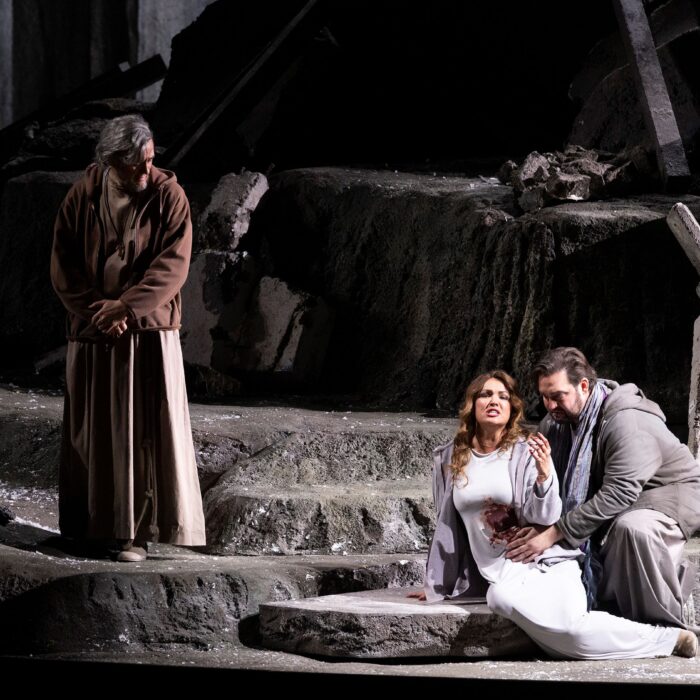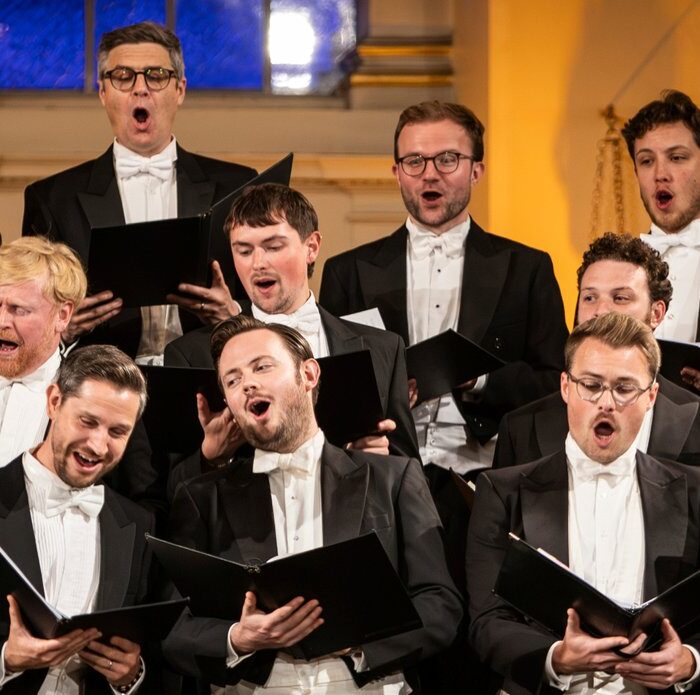
Théâtre des Champs-Élysées 2024-25 Review: Dialogues of the Carmélites
Olivier Py’s Visually Vibrant Production Features Star-Studded Cast
By João Marcos Copertino(Photo: © Vincent Pontet)
A few moments before the start of the opera, a friend of mine told me that this is the first time Aquarius has been in Pluto’s orbit since 1789. Whether or not that is true, I cannot say; I did not have the willingness to check. Still, it could be a sign from the stars that now is the time to watch the tale of the nuns who went to the guillotine.
Francis Poulenc and Georges Bernanos’s “Dialogues of the Carmelites” is one of the twentieth century’s greatest musical masterpieces. Its Catholic symbolism, dramatic tension, and sweeping harmonies promise musical beauty and political depth rarely matched. The Théâtre des Champs-Élysées’s revival of Olivier Py’s exuberant 2013 production is undoubtedly a visual triumph, but it falters due to uneven conducting.
Olivier Py’s Production Highlights
First things first: I greatly admire Olivier Py’s theatrical work. While his productions often share a similar style, this “Dialogues” stands out as an outlier in his repertoire. By shifting the plot from the Revolutionary era to a vaguely defined, shadowy past located somewhere between the late nineteenth century and the interwar period, Py heightens the symbolism that so powerfully captivates in Poulenc’s masterpiece.
Moreover, Py’s approach highlights something increasingly absent in most American operatic and theatrical productions today: aestheticism over mere stylization. Aestheticism prioritizes an overarching artistic vision, which need not be expensive but must be thoughtfully conceived. Py’s staging is both sumptuous and thoughtful. His mastery of light in predominantly dark settings, the minimalist use of elements, and the prioritization of gesture and movement are mesmerizing. Many American productions, even grand ones like John Dexter’s legendary “Carmélites” at the Met, used to embrace this aesthetic. However, contemporary trends lean toward expensive yet superficial stylization, relying on rotating stages and flashy effects while sacrificing substance. Ironically, in striving to look opulent, many productions lose the effortless grandeur Py achieves.
An example: few moments are as striking as Madame de Croissy’s deathbed scene at the end of the first act. Py creates the effect of a high-angle shot in cinema. While thus borrowing from cinematic aesthetics, Py avoids the cliché of projection screens. The plongée is deeply theatrical, showcasing Sophie Koch mesmerizingly sipping water while appearing physically embedded in a wall. It is this kind of theatrical illusion that makes Py’s staging so powerful.
Musical Details & Illuminating Cast
Regrettably, I found little to enjoy in Karina Canellakis’s musical direction. Actress Fernanda Torres recently campaigned for her Oscar nomination by quoting her mother’s acting rule: “If Hecuba cries at the first bad news she receives, she’ll end the play as a cockroach.” This wisdom feels apt here. Canellakis heightened the opera’s inherent tension so much, that its cathartic climax—the nuns singing “Salve Regina”—lost its impact. The relentless intensity left even sublime moments, like Véronique Gens’s “Ave Verum,” feeling rushed and strained, devoid of beauty’s aspirational breath.
This hyper-tense approach also strained the singers. Despite featuring one of the finest female casts Paris has to offer, the phrasing often sounded harsh, undermining the smooth vocal lines Poulenc intended. His muses—Denise Duval, Virginia Zeani, and Adele Addison—excelled at blending lyrical beauty with conversational intimacy. Here, the performers seemed to shout the text, losing the unique qualities of their voices. With a lesser-known cast, this might be forgivable, but when you have stars like Patricia Petibon, Véronique Gens, Sophie Koch, and Alexandre Duhamel, it’s disappointing.
Vannina Santoni was charming as Blanche, the opera’s most enigmatic character. Her voice, embodying both mysticism and fragility, carried the tension Canellakis demanded. Patricia Petibon, ever daring and committed, portrayed Mère Marie as severe and harsh, with clipped phrasing that sometimes obscured the text—a surprising choice for an artist of her caliber. Still, her willingness to take risks remains commendable.
In an opera where all the women are similarly costumed, and lighting is deliberately dim, Véronique Gens distinguished herself effortlessly. Her voice, the epitome of French grande dame artistry, stood out for its sweetness and elegance. Manon Lamaison brought liveliness to Sister Constance, her voice a welcome contrast to the surrounding gloom, particularly in the third scene of Act one.
Sophie Koch, as Madame de Croissy, delivered the evening’s most riveting moment: her death scene. Benefiting from her stage position’s acoustics, she showcased a commanding lower range and exceptional text delivery, particularly when voicing her character’s profanities. Alexandre Duhamel and Sahy Ratia were compelling as Blanche’s father and brother, respectively, with Ratia and Santoni’s chemistry subtly hinting at a deeper connection.
The orchestra, Les Siècles, brought a rougher texture to Poulenc’s score than we are accustomed to, often sounding harsh. While this was intriguing, it felt at odds with Poulenc’s lyrical orchestral idiom.
The Théâtre des Champs-Élysées’s “Dialogues” is visually vibrant and features a star-studded cast that will excite Parisian opera lovers. However, the uneven musical pacing and an overly tense interpretation undermine the opera’s dramatic subtleties.
Categories
Reviews

